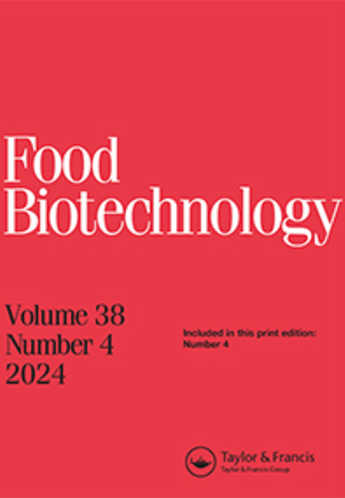F型肉毒杆菌神经毒素催化结构域的表达与纯化:免疫学特性及其在检测中的应用
IF 1.6
4区 农林科学
Q4 BIOTECHNOLOGY & APPLIED MICROBIOLOGY
引用次数: 0
摘要
肉毒杆菌神经毒素(BoNT)是世界上已知毒性最大的生物分子(⁓毒性是氰化物的100倍),已被列为A类生物战剂。在本研究中,我们克隆了BoNT型' F '的催化结构域。重组BoNT/F蛋白在21°C、0.75 mM IPTG条件下,诱导后6 h达到最大表达量。rBoNT/F蛋白纯化后经MS-MS分析和Western blot证实。产生高滴度的多克隆抗体,观察到IgG1同型水平升高。建立了检测BoNT/F的ELISA试剂盒,灵敏度为3.9 ng/mL。以rBoNT/F Lc蛋白为抗原,建立了不同果汁的检出限(LOD),苹果汁的检出限为15.62 ng/mL,荔枝为31 ng/mL,葡萄、橙汁和芒果汁为62 ng/mL。开发的系统具有检测食品和环境样品中的BoNT/F的潜力。本文章由计算机程序翻译,如有差异,请以英文原文为准。
Expression and purification of catalytic domain of botulinum neurotoxin serotype ‘F’: immunological characterization and its application in detection
ABSTRACT Botulinum neurotoxin (BoNT) is the most toxic biomolecule known to the world (⁓100 times toxic than cyanide) and has been listed as category ‘A’ biowarfare agent. In the present investigation, we cloned the catalytic domain of BoNT type ‘F’. Maximum recombinant BoNT/F protein expression was achieved at 21°C, 0.75 mM IPTG at 6 h post induction. The rBoNT/F protein was purified and confirmed subsequently by MS-MS analysis as well as Western blot. High titer polyclonal antibodies were generated and elevated level of IgG1 isotypes was observed. Plate ELISA was developed for the detection of BoNT/F with the sensitivity of 3.9 ng/mL. Limits of Detection (LOD) was established for different fruit juices through spiking studies using rBoNT/F Lc protein as antigen and achieved a detection limit of 15.62 ng/mL for apple juice followed by 31 ng/mL for litchi and 62 ng/mL for grape, orange, and mango juices. The developed system has the potential for the detection of BoNT/F in food as well as environmental samples.
求助全文
通过发布文献求助,成功后即可免费获取论文全文。
去求助
来源期刊

Food Biotechnology
工程技术-生物工程与应用微生物
CiteScore
3.80
自引率
0.00%
发文量
15
审稿时长
>12 weeks
期刊介绍:
Food Biotechnology is an international, peer-reviewed journal that is focused on current and emerging developments and applications of modern genetics, enzymatic, metabolic and systems-based biochemical processes in food and food-related biological systems. The goal is to help produce and improve foods, food ingredients, and functional foods at the processing stage and beyond agricultural production.
Other areas of strong interest are microbial and fermentation-based metabolic processing to improve foods, food microbiomes for health, metabolic basis for food ingredients with health benefits, molecular and metabolic approaches to functional foods, and biochemical processes for food waste remediation. In addition, articles addressing the topics of modern molecular, metabolic and biochemical approaches to improving food safety and quality are also published.
Researchers in agriculture, food science and nutrition, including food and biotechnology consultants around the world will benefit from the research published in Food Biotechnology. The published research and reviews can be utilized to further educational and research programs and may also be applied to food quality and value added processing challenges, which are continuously evolving and expanding based upon the peer reviewed research conducted and published in the journal.
 求助内容:
求助内容: 应助结果提醒方式:
应助结果提醒方式:


